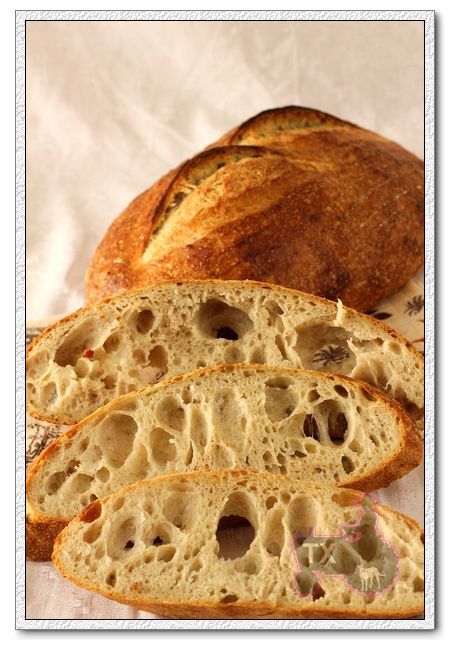
I received my copy of the new "Tartine Bread Book" last week, flipping through the book, I was struck by two things: 1. I want Chad Robertson's life (especially the part about living in the French hills with artisan bakers/cheese makers/farmers, living and doing what he loves along the coastline of beautiful Northern CA, oh yeah, let's not forget the part where he and his friend surf in the morning and bake in the afternoon!); 2. I have been making those 36 hour sourdough baguettes with high hydration, no kneading but S&F, long fermentation, and Chad Roberton's method is very similar in these aspects.
I made his basic country loaf this past weekend with great result. The formula and procedure have been well documented in detail here, and the following are my "study notes":
1. He is after a bread with balanced flavor without too much sourness (I guess his French study is showing), so he ues a levain (a.k.a. sourdough preferment, sourdough poolish) that's very young. In fact, he says to use it when it has JUST started to float in water, only expanded 20% in volume. He accomplishes that by adding a lot of water and flour to a very small amount of starter (100%), and leave it overnight at a very cool temperature (65F). This is dfferent from the usual practice of using the levain when it has reached the peak volume.
2. He use a very small amount of levain in the main dough: 200g of levain at 100% in 1000g of flour, which means only 9.1% of the total flour is in the levain.
3. He uses relatively warm water to mix the main dough, and the bulk rise temp is pretty warm too (78F to 82F), which counter-balance point 1 and 2 above, to speed up the bulk rise somewhat
4. At the end of bulk rise, he only aims for a 20% to 30% volume increase in his main dough. That takes 3 to 4 hours at the warm-ish temp he describled in the basic flow, but can also be modified according to preference. For instance, lower the water temp to 65F, and keep the dough at 60F, the bulk rise could take 10 to 12 hours, a convenient overnight schedule. (Food for thought: I often wonder how much bulk rise a dough really needs. I know it needs some to build up basic strength and falvor, but I have seen and tried a variety of fermentation schedules, some put more time in bulk rise less in proofing, some do the opposite. Of couse each can be successful, IF it satsify some basic rules, and each would produce breads with different flavors. My conclusion so far is that different style of breads would prefer different fermentation schedule. For instance, the book mentions an example where a pan bread that would have support thoughout proofing and baking could have a very short bulk rise since the dough needs less strength, while a free form loaf may require longer bulk rise. In addition, I think a fuller bulk rise would change the crumb structure too.)

5. The dough is very wet. He says the basic formula is 75% hydration, but he's not counting the 100% levain, it's actually 77%+, wetter than my usual baguette dough. I used all the water (two addition, the last 50g is added after autolyse), the dough felt silky and easy to handle - yes, it's wet and sticky, but I have been making very wet baguettes every week, so I am used to the "wet glob" kind of dough. The "let time and fermentation do their job" method works well here again, don't be freaked out by the initial puddle of mess, give it a couple of hours and some S&F, you will see how it will turn into a beautiful silky cohensive "puddle".
6. After I posted about the 36 hour baguettes, some have asked me about how to S&F such a wet dough. As I mentioned in that thread, I simply take the dough out, hold it in my hands, left hand strentching out, then fold back. Repeat with right hand. Put back in the container. The key is to have the container and hands well oiled. When I do that with my baguette dough, it was easy, and quick, and efficient. However, when I tried to do that with this dough, I immediately realized that it's not the best way - because the dough is much larger. My baguette dough has 500g of flour, this one has 1100g, and I have small hands. If I try to do the same thing with this dough, it would try to slip off, so I had to dig my fingers into the dough a bit to grab on, which hurts the dough. So I changed to Chad's method describled in the book: folding the dough in the container. My point is that it's not important to known how exactly a S&F is done, it's important to know the principle. YOu need to stretch out and fold the dough back GENTLY. Once - in a way that's most convenient for you.
7. With such a wet dough, it's the best to make simple shapes. I made a boule and a batard, both have very open crumb, but the boule has more and larger holes, because it was handled less during shaping. (Who's up for shaping this dough into baguettes? I can't get the thought out of my head, there's something wrong with me! The funny thing is that Chad's baguette formula has LESS water than this country loaf.)
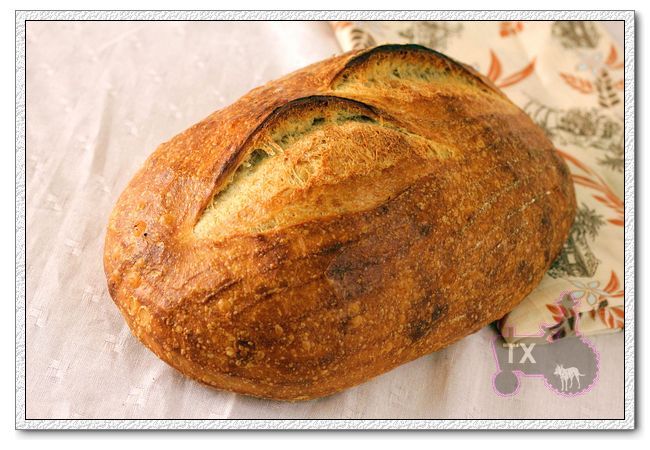
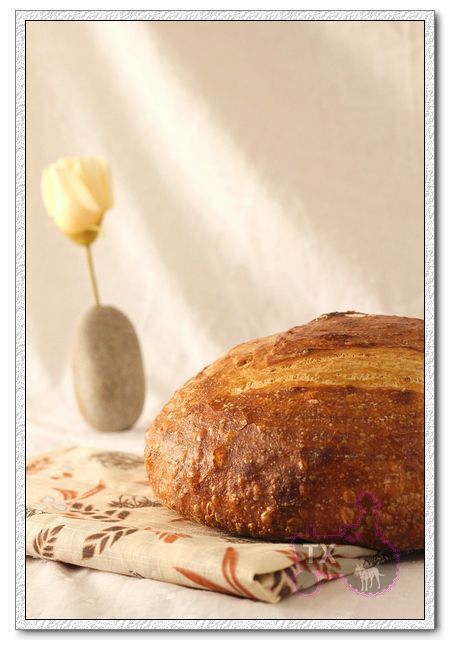
8. I retarded the shaped dough overnight at 40F, put them at room temp for another hour the 2nd morning to finish proofing, then baked. The book says I can proof and bake on the same day of bulk rise, but I never seem to have that much time in one day, and I like the flavor better after a long proof.
9. The crumb is VERY open, to the point that it's hard to slice. Especially the boule, which has a large crosssection and the crispy crust is thin, I think I need an electric slicer to cut through those airholes cleanly, now I know why hole-y baguettes are shaped long and thin, so there's more crust support and easier to cut!
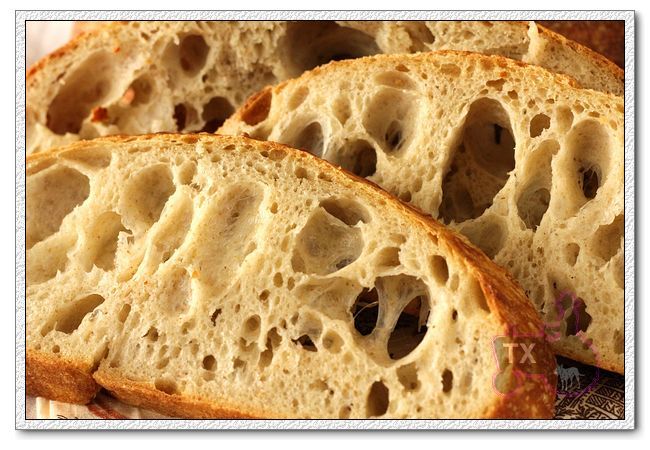
10. The book ueses a cast iron dutch oven set to bake the bread in, I don't have such things, so I baked them on my stone with steam. I can see how they spreaded out a bit on the stone in the first few minutes, but then quickly sprung up beautifully to give great volume. However, I can see how a vessel with limited space can contain the shape even better to give a higher/rounder shape. Next time I may try a higher baking temp for the first few minutes.
11. The flavor is sensational. Very moist, cool crumb, matched well with crackling thin crust. What struck me the most is the sweetness. Even after a night of retarding, there's barely any sourness, but the sweetness of the wheat is very apparent. My husband and I both loved it.
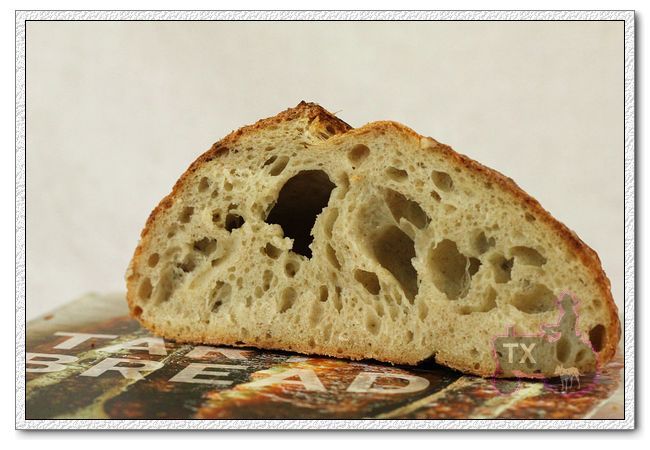
Next up: I want to try the WW loaf in the book, even MORE water!
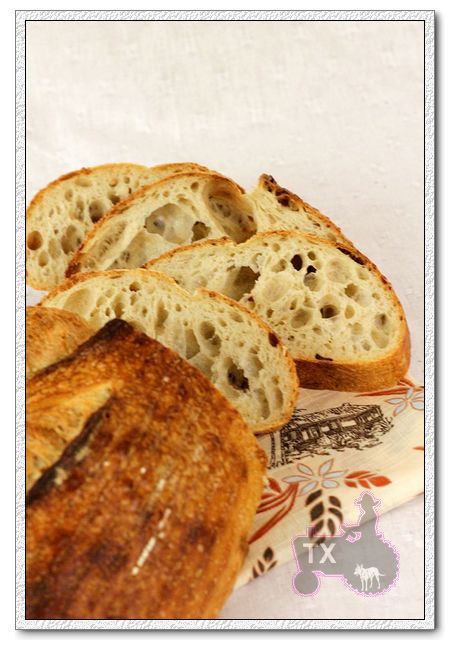
Submitting this to Yeastspotting.
- txfarmer's Blog
- Log in or register to post comments
Absolutely fantastic write up! Your loaf is outstanding and your practice with all those highly hydrated doughs really shows.
I'd love to see your whole wheat when you attempt it.
I am excited about the ww too, curious to see how this method would work.
baker and equally gifted writer and photographer. The results are just spectacular. I, too, like a mild sourdough, and I think I've found the procedure through his text.
I'm looking forward to more of your reviews, TxFarmer. Thank you for sharing your work with us.
Bernie Piel
Your detailed post about the book was very inspiring. Like you, I am excited to try more formulas from it. Other than the ww, I am also curious about some interesting flavor combinations, as well as the croissant and broiche.
As a novice, I have not yet ventured into the sourdough arena, but hope to soon.
I do not care for a strong sourness however, and have been on the lookout for a milder sourdough, like the French prefer.
I'm experimenting with a long cold ferment now, so this would be a natural next step.
This one looks like it's worth a try, as I am also fond of very large holes and airly crumb.
Beautiful pictures, excellent reporting! Thanks!
I highly recommend to get the book, it has in depth explanation of the procedure to help you understand the "how" and "why" of everything.
Wow, what a beautiful crumb structure. This looks like a great book. I am anxious to see what else you bake from it. As always, your breads are a thing of beauty and your notes are so detailed. Thanks for sharing.
This is definitely a book worth buying.
But I think your 36-hour sourdough is much nicer!
How many bread formuals are in the book, txfarmer?
I prefer a defined tang in my bread, so I may wind up checking out the book through my library instead of buying it.
Even though his ideal bread is mild, but the process can be easily modified to change the flavor. For instance you can let the levain mature furthur before adding it to the main dough, and you can do the bulk rise at a cooler temp for much longer, both would add sourness to the final bread.
This is a typical "bakery" bread book, which means it has a couple basic formulas (one is this basic country loaf, another one with higher ratio of ww, third with semolina, fourth being a light rye), then some flavor variations based on each. This is common for other bakery books including "Bourke St. Bakery", "Breads from La BREA Bakery", "Amy's Bread" etc., which makes sense since that's how bakeries operate. In addition this book also has formulas on baguette, brioche (there's an olive oil version that looks very interesting), croissant, which all use a combination of dry yeast and sourdough. The last 1/3 of the book is devoted to dishes that's made from bread, not just sandwiches, but also soups, salads, etc, very delicious looking.
There are some excellent reviews on Amazon for this book.
I prefer a mild sourdough, do not like a sour bread, so it's been my impression that I would like his book, as he does sourdough like the French, not the San Fransisco way.
I don't think there are a lot of bread recipes in the book from the reviews I read, but there are a lot of recipes to accommodate bread, and to use bread in.
Also get the impression the book tries to impart a sense of how to feel the dough and the baking experience, which I also like.
From what I've heard, it sounds like a book I will enjoy, after I get through my Rinehart books.
Please see above about recipes in the book. I'd say it's a great next step after you are done with BBA and have a stable starter.
Farmer, beautiful, as always. Could you please describe your setup for retarding the formed loaves you picture overnight? Seam side up or down, containers or freeform, etc? Much appreciated.
seam side up, very well floured brotform, fridge temp 40f. With this wet dough, you need to make sure the brotform is not too big.
I only asked because the photos show so little flour atop the loaf. It looks great.
I usually don't like to have too much flour on my dough - want the crust to brown and crack properly, so my version of "very well floured" may be different from some other people's. I put a mixture of rice and AP flour in the basket, slide the flour around to make sure every seam gets some, then I dump out the extra.
Great Job TxFarmer!
I can't believe you managed to make a loaf that wet with such minimal residual flour. That alone I find inspirational. (Though the bread certainly qualifies as well!) Nicely done!
Jay
I'm with you farmer, regarding the floured crust.
I like the rustic look of it, but prefer the taste and feel of little or no flour.
I love the light crunch of a paper thin, crisp crust.
I just pulled a rack of baguettes using Rineharts cold ferment, perfect crust, incredible flavor, best I've made yet.
Why the rice flour? How does it affect it differently from white flour?
The addition of rice flour would prevent sticking better - a trick i learned right here on TFL. Tartine book also mentioned the same trick.
Is expensive!
I saw some at WalMart today, over $3 for a small package, maybe a pound or less.
I live in the Panhandle of North Idaho and King Arthur Flour is about 6-7 dollars for 5lbs at most of the groceries stores. To me that is expensive, but the local WalMart sells King Arthur Flour for $3.36 for a 5lb bag of either Bread Flour or All Purpose. That is a great buy for King Arthur Flour !! Hardly what I would call expensive.
You've got beautiful loaves. I must try the whole wheat too.
I found the volume of the recipes very generous, but assume he did that to maintain the 1000 grams flour as a base so it's easy to understand.
I think the major contribution of this book is the mild levain with 50% whole wheat flour. It's an interesting combination, the whole wheat really makes the starter very active but the small percentage of chef takes it in the opposite direction. But generally I found his levain more vigorous than a plain white starter.
His other major contribution I think is the stretching technique to form the loaf. That's worth the price of admission alone. Finally, the food recipes at the back are SUPERB.
The bread pictures in the book are also among the best I've seen anywhere.
As for the recipes, I was also baking with this book when it was warm (early Sept in DC) and found it difficult to get the right temperatures:the recipes obviously derive from the mild temperatures of San Francisco and Point Reyes, such as rising at 65F. Now, with it cooling down especially at night, I'll have a better chance.
Hi TxFarmer,
beautiful breads as always!
just gave the tartine basic country loaf a ashot based on the formulas i've found here.
as usual, noted some things to improve on the next round - sigh, do i never learn from my mistakes...but i have a question for you.
coincidentally i use the same stretch dough out in both hands and fold over each end as you do. I just fumbled my way into this by instinct but instincts fail me when it comes to shaping such a wet dough. I know my dough was lacking in strength - on hindsight i needed to do more S&F - but it spread and was just so wet i gave up trying to shape it at all. So i just plopped the dough into a bowl and tried to make a boule shape just before putting it into the oven. I also had difficulty slashing even though i floured the top of the loaf.
Do you use flour/oil on your hands and worktop when you shape very wet doughs?
thanks!
I just use enough flour so it doesn't stick , then shape as normal into boule or batard. The key is to do it quickly with minimal tugging and touching.
Sounds like your dough lacks strength with would contribute to shaping and slashing difficulties.
it lacked strength. thanks for replying!
dear TXfarmer,
hi,
thanks for sharing your beautiful bread,
i made tartine country loaf many times with diferent kinds of flour, i have some problems with this dough.
1- its very hard to work with it because of high hydration in the dough, its really hard to shape it into batard. i dont know how to do that.
2- i made it with less water than the book said( 65% ) and it seems better to work with but another pb comes through, when dough goes to oven it becomes flat ( in both shapes batard and boule ) i bake with baking stone.
3- there is not huge diferent in crumbs in both 75% and 65% but crumbs have elongated shape and i think its because of flat form of bread
4- is it good to put the dough in a pot or plate then put it in the oven? i think it can save the shape of the bread in batard
any suggestions...??
1. Practice helps;
2. No oven springs means one or more of the following : not enough gluten developement due to insufficient S&F/in sufficient bulk rise; overproof; not enough pre-heating
3. Given 2 above, it's not suprising they are similar
4. Baking in a pot can preserve the shape, but not the crumb problem caused by the reasons listed in 2 above. The real solution is to practice and find out what's the proper gluten developement (try S&F more), and bulk rise (if you dough is that much drier, bulk rise may be much slower since wet dough fermentate faster). As well as your oven temp.
I just started learning how to bake one using this recipe and have been painfully trying to shape this into a baguette...... and oh my i guess i should stop after 3 tries. Thank you for all your notes, will try to shape this one in a boule or baterd ???.
oh, donyou possibly have an advise - During the bulk fermentation, doing the S&F every 30 mins for 2 hours, at the end of the second hour my dough fees like it slowly looses its strength than actually building one. After that I try to make few coil folds :( Yes it’s shiny and pillowy but when it’s time to shape, it just never gets to the right strength to form a shape :(. Or is it because I’ve been trying a baguette shape? ??